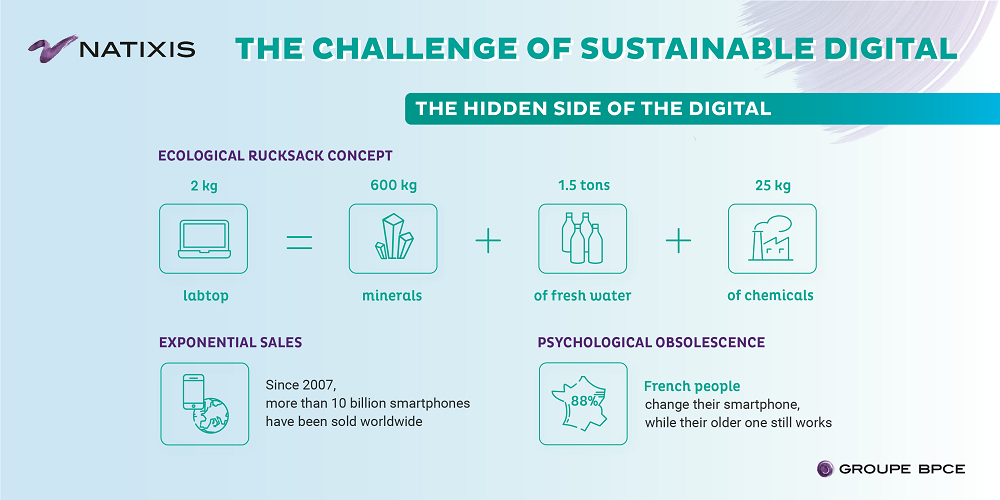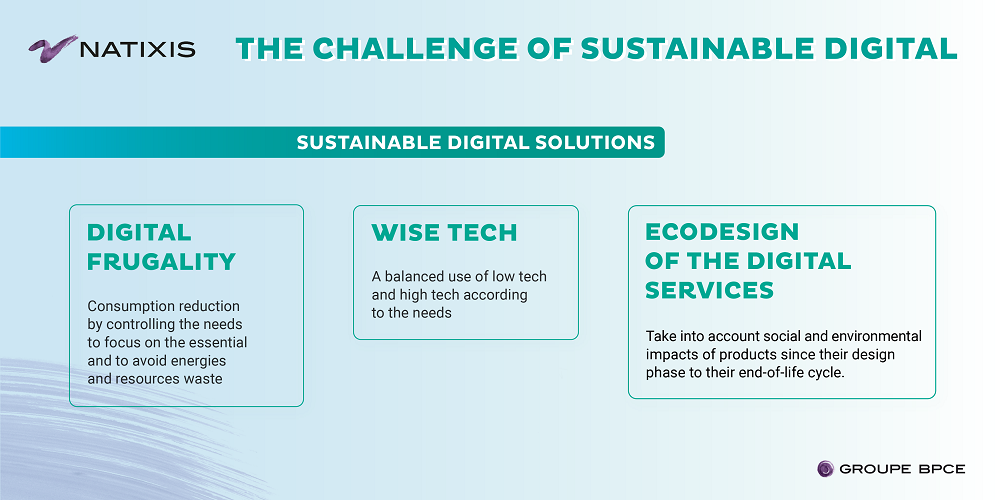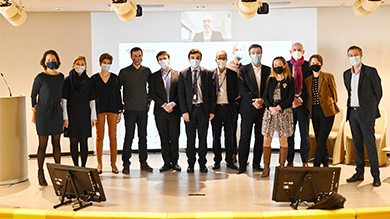Digital has revolutionized companies and organizations at a fast pace. Digital offers innovation and progress provided it respects ethical and sustainable values for the benefit of societies and environments. To reach this goal, companies adopt sustainable digital principles to optimize their IT tools while limiting their negative impact. What are the compagnies’ strategies to promote sustainable digital? Discover the explanations from Philippe Derouette, Enterprise Architect for Sustainable Digital at BPCE and from Marie Joron-Mélyon, Sustainable Digital Manager at Natixis through this Green Momentum podcast.
MARIE
JORON-MéLYON
Sustainable Digital Manager at Natixis
PHILIPPE
DEROUETTE
Enterprise Architect for Sustainable Digital at BPCE
The hidden face of sustainable digital: impact and pollution
We widely underestimate the digital footprint. If digital seems invisible and virtual, its impacts are concrete: be it digital device manufacturing, transportation, distribution, consumption, or recycling process. For instance, 600 kilos of minerals are required to manufacture a two kilos laptop. 1,5 tons of fresh water and up to 25 kilos of chemicals are also used in the manufacturing chain. This is called the ‘ecological rucksack’: all the used natural resources are taken into account from the extraction of raw material to the manufacturing of the final device. The ratio is very unbalanced: high-tech device manufacturing requires up to 350 times its weight in raw materials. It represents 500 kilos of raw materials for the manufacturing of an internet box.
Quite often, IT devices manufacturing is more polluting than its consumption. Let’s consider the modern extension of our hand: smartphones! Did you know that IT devices are more polluting than data centers? How is it possible? Because they are widespread: more than 5.19 billion people use a mobile phone in 2020. Since 2007, 10 billion mobile phones have been sold worldwide.
Aftermath and impacts of our daily devices such as computers, smartphones or screens are multiple: rarefaction of abiotic resources, raise of raw materials and energy consumption, increase of greenhouse gas emissions, destruction of biodiversity, generation of waste etc. Societal and environmental risks can lead to hydric stresses, geopolitical tensions, mental health damage, or even psychological obsolescence*. 88% of French people change their smartphones while their former device still works. Yet, IT devices mass usage is a key stake for companies, which depends on these technologies.
Digital stakes for companies
Digital is key for economic and social development. Jobs and services have become highly competitive due to new technologies. Digital investments and innovation pave the way for new products and services. Companies digitalize their activities and processes to simultaneously succeed in their energy and digital transition. Their main goal is to lighten their carbon footprint, digital being a large part of it.
However, constantly evolving technological services result in new needs and especially new ways of consuming. Companies try to regulate them through dedicated solutions and procedures designed to save energy and resources. Sustainable digital has become a cornerstone for SRI strategies. It highlights good practices without undesirable “rebound effects”*. On the ground actions to identify and simplify consumer journey are numerous: internal evangelization, KPIs indicators, energy equipment reduction, new sustainable IT rules etc.
Customized solutions: from ecodesign to frugality
Levers of actions to reach sustainable digital within companies are numerous. First, the needs evaluation is key to determine if technology is necessary or not. For instance, is an automatic email featuring heavy links and images justified? Alternating low tech and high-tech solutions according to the desired needs is a smart approach to wise tech enabling a better flexibility.
Ecodesigning software and programs is an excellent mean to better evaluate the use cases. Interfaces can be conceived as more energy efficient. Frugality concept is applied in sustainable digital to avoid energy and resources waste. Thus, the reduction of consumption is reached by a smarter management of the needs and focusing on the core ones.
On a wider scale, each one of us can daily apply good sustainable digital practices. Here are a few examples:
- Avoid the multiplication of equipment and reduce the number of connected objects
- Keep the devices longer: using a tablet or a laptop four years instead of two improves by 50% its environmental balance
- Repair, refurbish or recycle the electronic devices
- Ecodesign digital services by anticipating the needs notably in terms of data and storage to improve their carbon footprint
Responsible actions be it in the personal or professional space help reducing the digital footprint for a better sustainability, an ethical awareness, and more ingenious practices. One must keep in mind that digital is a non-renewable resource.
INFOGRAPHICS
Key concepts
Abiotic resources: Set of physico-chemical factors from a nonliving ecosystem, as climate or habitat, that influences or affects an ecosystem and the organisms in it. It is the action of the nonliving on the living. Here we can talk about the IT equipment impact on the resource ecosystem and on the worldwide populations, which are limited. Digital must be considered as a non-renewable resource.
Psychological obsolescence: Phenomenon where consumers change a viable product that is still working because it appears to be outdated or out of fashion compared to similar products, notably for technologies. For high tech devices, aesthetic obsolescence is often coupled with technological obsolescence.
Rebound effect: Identified during the industrial revolution, the rebound effect shows how the energy performance improvement of a particular item such as a locomotive or a computer doesn’t diminish its consumption. Instead, a global energy consumption growth is witnessed according to the technical function of the item – in these cases railroad transportation or IT needs. This Jevons paradox leads to an increased demand and an overconsumption effect.


















